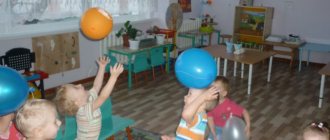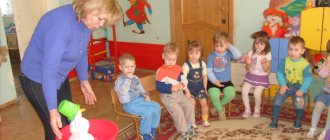Game "Masha-Rasteryasha"
Goal:
to train attention, the ability to see resources for solving problems.
Preceding stage:
familiarizing children with the functions of various objects.
Why a spoon? Why a door? Why a knife?.. Introduction to the game:
tell (with an appropriate conclusion) about inattentive people who confuse and lose everything.
Invite the guys to provide friendly assistance to such Confused Mashas. Progress of the game: 1st option:
the presenter himself takes on the role of Masha the Confused Man and turns to the others: - Oh!
- What happened to you? — I lost (names some object, for example, a knife). What will I do now (names the function of a lost object, for example, cut bread)? The players name the resources to perform this function, for example: saw, axe, fishing line, ruler; You can break it off by hand. Masha-Rasteryasha can provide a small reward for good advice. 2nd option:
the same as in the 1st option, but the role of Masha the Confused is given in turn to all participants in the game.
Before the game starts, the presenter can ask the children to make a wish for the lost object. Then he appoints one of the children as Masha the Confused. You can appoint, for example, a neighboring child as the defendant. Then, after a successful answer, he becomes Masha the Confused Man and turns to the next participant in the game in the chain. This ensures that every child participates. But the rest quickly get tired of waiting their turn. You don’t have to appoint a responder; let everyone answer Masha the Rasteryasha’s question, after which the role of Masha the Rasteryasha passes to the next player in the chain. But then not everyone will actively participate in the game. You can combine approaches when, for example, a neighbor should answer first, and the rest can complement. Then Masha-Rasteryasha can evaluate the answers and choose the best one. And whoever gave the best answer becomes Masha the Confused - after all, it is known that “confusion” is contagious... Complication for teachers familiar with TRIZ:
Development of the game with a transition to the Ideal Final Result: the same as in the 1st or 2nd options, but after the proposed answers, Masha-Rasteryasha suddenly begins to speak like Emelya from the famous fairy tale: “And now, at the behest of the pike, according to my desire, I want (the function of the lost object to be performed itself, for example, the bread will be cut off by itself).
The others should suggest how to do it (for example, the bread is already pre-sliced to the bottom crust). Development of the game with the transition to contradictions:
the leader leads the children to a contradiction created: a) as a result of the promotion of IFR (for example, bread should be cut already in the store so that the buyer does not have to cut it and the bread should not be cut so as not to fall apart pieces are still in the store. Solution using the method of combining: sell bread in deep plates, tie it with a bow, wrap it in paper); b) as a result of discovering the shortcomings of the proposed solutions (for example, the fishing line must be sharp to cut bread, and must be blunt so as not to cut into fingers. The solution is by separating in space: the middle of the fishing line is sharp, and the ends are blunt, wrapped in a rag). Children can independently or with the help of a facilitator formulate and resolve contradictions, depending on their skills at this stage.
Game "Stop the thief!"
Goal:
to train analytical thinking, the ability to identify distinctive features through comparison.
Previous stage:
the game “Teremok”.
In contrast, in this game visual support is given only for one object of comparison, the other must be imagined mentally. Props:
the same as in the game “Teremok”.
Introduction to the game:
shouts are heard in the crowd: “Stop the thief, he’s so tall!”
- Stop the thief, here he is in the black hat! No one noticed the thief himself, no one can describe him completely. But detectives find a thief even based on individual signs... So we will try to find a “thief”, knowing some of his signs. Progress of the game: 1st option:
each child holds a drawing in front of him and plays for the drawn object.
The leader assigns 3-4 children to the search group and removes them from the room. The rest are determined by lot or counting - who will be the “thief”, and the children name his signs (for example, a teapot: patterned, with a handle, empty). Then the detectives return to the room, the leader tells them the signs of the thief and calls: “Stop the thief!” The rest of the children can sit, stand, and run. Detectives run between the children, look at their drawings and try to identify the thief. When each detective has detained someone, the presenter says “stop!” and all movement ceases. The detainees are being examined. The leader sets the order of consideration so that the real thief, if caught, remains the last. The first detective points to his detainee and says: “This is a thief, because he ... (names a sign known to him, for example, “With a pen”).” The detainee, if he is not a thief, says in what other ways he differs from a thief: “No, I am not a thief, because... (for example, if a bag is “detained”: “The thief keeps the tea, and I keep the books”). If the detainee cannot tell the difference, he is taken away as a thief. And so on until all the detainees were examined. A real thief, if caught, can only voluntarily confess. Let him give back what was “stolen” and receive forgiveness. Investigators can be rewarded. 2nd option:
The same as in the 1st option, but each detective is told only one of the established signs.
Then it is more difficult to find the thief. Note.
Perhaps the game's plot could be given more noble features. The author leaves the initiative to the Reader.
In recent years, a new direction in the development of children's creativity has spread - TRIZ (the theory of solving inventive problems), which was created by the scientist-inventor T.S. Altshuller. This is applied dialectics, that is, a system of knowledge about the laws of development, the rejection of the trial and error method in science, technology, and in our everyday life.
Elements of TRIZ began to be perfectly integrated into preschool education, thanks to the technical workers of the city of Norilsk M. Shusterman and A. Shub, who developed a methodology in accordance with the age characteristics of children 4-7 years old.
The teacher uses non-traditional forms of work that put the child in the position of a thinking person. TRIZ technology adapted for preschool age will allow you to educate and train a child under the motto “Creativity in everything!” Preschool age is unique, because as a child is formed, so will his life, which is why it is important not to miss this period to reveal the creative potential of each child. The purpose of using this technology in kindergarten is to develop, on the one hand, such qualities of thinking as flexibility, mobility, systematicity, dialecticity; on the other hand, search activity, the desire for novelty; speech and creative imagination.
The main goal of using TRIZ technology in preschool age is to instill in the child the joy of creative discovery.
To do this you need:
Organize activities in such a way that they naturally fit into the natural life of children
Have a special toy - the hero of the lesson, which “helps” the teacher. Problematic questions are asked on behalf of the toy, and educational dialogues on the topic of the lesson are held with it. The toy actively expresses its opinion, asks and clarifies what is not clear, sometimes it makes mistakes, gets confused, and does not understand. A child's desire to communicate and help her significantly increases activity and interest.
At the end of the lesson, sum up the results in order to teach children the skills of reflective analysis (what they did, what they learned new, what remained unclear, etc.). The results are summed up in a wide variety of forms: games “interview”, “news box”, “finish the sentence” and others; discussion of plans for the future (today we learned about ..., and next time we will also learn about .....); productive activity and discussion of the received work. At the same time, it is desirable to ensure a natural transition for children from one type of activity to another, linking the content of the lesson with the subsequent regime moment. After summing up, the children part with the toy until the next lesson.
In the second year of study, conduct not only collective cognitive exercises, but also individual ones on any surrounding material. These exercises can be recommended to parents for developing communication with children.
Be ready to use the “TRIZ” approach in everyday interaction with children, be able to independently notice and strive to resolve contradictions, be able to systematically perceive and analyze the situation.
The main criterion in working with children is clarity and simplicity in the presentation of material and in the formulation of a seemingly complex situation. You should not force the implementation of TRIZ without children understanding the basic principles using simple examples. Fairy tales, playful, everyday situations - this is the environment through which a child will learn to apply TRIZ solutions to the problems he faces. As he finds contradictions, he himself will strive for an ideal result, using numerous resources.
In any communication with children, you should try to be based on RTV methods (development of creative imagination). One of the directions is the use of visual activities as a fundamental component in teaching children creative thinking based on TRIZ. The use of modeling, appliqué, and design is important for the initial modeling of some inventions or situations. But for complete creative emancipation of children, it is necessary to stimulate imagination in relation to creation - this is the main thing in TRIZ pedagogy.
You can use only TRIZ elements (tools) in your work if the teacher has not sufficiently mastered TRIZ technology.
The game is, as it were, a starting point for further transformation, development and creation of many interesting options.
Let’s look at one of the main RTV methods for identifying contradictions – the “good - bad” exercise. A scheme has been developed using the method of identifying contradictions:
The first stage is the determination of the positive and negative properties of the quality of any object or phenomenon that do not cause strong associations in children, for example: a wooden pencil, hot summer.
The second stage is the determination of the positive and negative properties of an object or phenomenon as a whole, for example: a pencil or summer (in general, a complete description).
Only after the child understands what adults want from him should he move on to considering objects and phenomena that evoke lasting associations.
Often, the teacher is already conducting TRI classes without even knowing it. After all, it is precisely liberated thinking and the ability to go to the end in solving a given task that is the essence of creative pedagogy.
Compiled by E.I. Biryukova. teacher of the highest category
MBDOU kindergarten No. 1 “Beryozka”
Svetlogorsk, Kaliningrad region.


